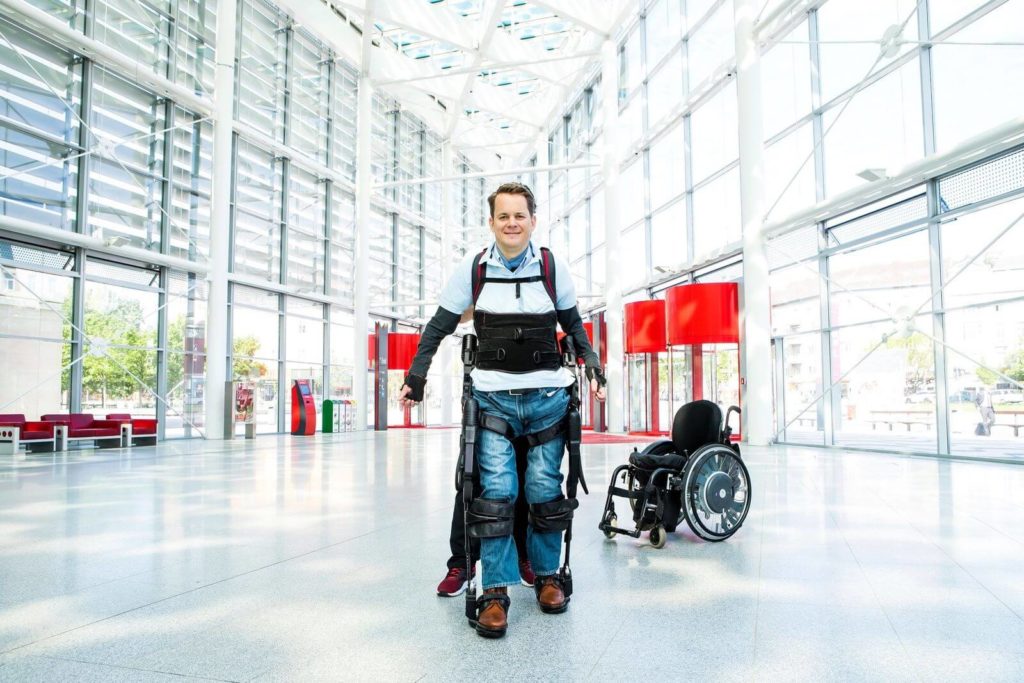At the age of 18, Gregor Demblin had an accident and has been in a wheelchair ever since. But now he can take steps again - with the help of an exoskeleton.
Gregor Demblin was on a trip to take his Matura. He jumped into the water - and when he next opened his eyes, he was in Vienna General Hospital. The diagnosis: paraplegia. "For me, a world collapsed. I wanted to travel to the USA on a one-way ticket and see what awaited me there. That plan collapsed like a house of cards." He was just 18 years old at the time of the accident. Doctors gave him no hope that he would ever be able to leave the wheelchair again. "Instead of the adventure of the U.S., I was now in intensive care. My first thought was, why did you survive this?"
Demblin is not alone in his impairment. There are around three million paraplegics worldwide. The cause of paraplegia is always damage to the spinal cord, which can be congenital or caused by an accident. Walking is then no longer possible for those affected. However, 20 years after his accident, Gregor Demblin has still found a way - with the help of an exoskeleton.
Relearn every movement
For the young man, the next stop was the rehabilitation center. There he learned how to do normal things again, such as eating independently, writing and brushing his teeth. But he wanted more - and trained intensively every day: "I was sure that if anyone in the world could learn to walk again after paraplegia, it would be me. I was young, I was motivated, I was athletic." And even though therapies ended at 4 p.m., Demblin continued to make laps in his wheelchair for hours to build up strength.
After a year, the doctor treating him then brought him in to make it clear that the injuries were simply too great: "He told me that I had to face reality. After a year, I couldn't even wiggle my little toe. That's when I realized that being in a wheelchair wasn't just a passing phase." It's true that he had actually made enormous progress during that year: "I had to practice every little movement again. But I had to say goodbye to the fixed idea that I would only leave the rehab center walking." The young man had to learn that even in a wheelchair you can make the best of the situation: "It wasn't an easy road, but in the meantime I'm married, have four children and have even built up two businesses."
New hope
A crucial turning point was when Demblin learned about the exoskeleton - about 20 years had passed. This apparatus supports the body and enables safe standing and walking by means of electrically operated motors. The legs are moved, partially or completely replacing the work of the muscles. When Gregor Demblin first saw a video about an exoskeleton, he was "obsessed with the idea of trying it out, too."
And although several doctors dashed his hopes of walking again with an exoskeleton, he didn't give up. "I still didn't let them dissuade me from my plan, and I went on a search." Eventually, he found what he was looking for in Germany. Physiotherapist Dennis Veit owned an exoskeleton, and after a few discussions, and despite the doctors' concerns, he took it to Demblin in Vienna. "Because of the location of Gregor's spinal cord injury, the doctors probably felt that the systems available on the market were not suitable for him," says the physiotherapist.
And that's where Veit sees the problem: "There are still significant gaps in knowledge today, ten years after exoskeletal systems were introduced to the market, although many can benefit from this technology." Mobile and stationary exoskeletons are suitable for people with conditions across the neurological spectrum. "The major indication groups are stroke, spinal cord injury, multiple sclerosis, traumatic brain injury and cerebral palsy," the expert knows.
Forgotten perspective of the world
And indeed, after more than 20 years spent purely sitting down, Gregor Demblin was able to stand up again for the first time with the help of the exoskeleton: "That was an absolutely indescribable feeling. I had completely forgotten how tall I actually am and what the world looks like from a standing perspective. I also took 400 steps right away during my first workout. That was just completely indescribable for me."
Physiotherapist Veit knows how important this movement is for people in wheelchairs: "Most neurological diseases result in greatly reduced mobility and activity for those affected. This promotes obesity, cardiovascular disease, diabetes, osteoporosis, urinary tract infections, open skin sites and even depression, among other things." The result is a high mortality rate, even among younger sufferers. "Imagine a 10-hour non-stop flight to the United States. How do you feel if you couldn't even stand up during that time? That's what many of our patients experience day after day."
For Demblin, the training device opened up a forgotten world - and he did everything he could to bring it to Austria, too: "I wanted other people in my situation to be able to benefit from it, too." The idea gave rise to his company Tech2People, a center for robotic neurotherapy that offers robotic as well as classic physiotherapy.
The positive effect is quite clear to him: "I've been exercising regularly for five years. And since then, my health has been much better. I have fewer infections and no longer have to take antibiotics, which I had to take constantly before." And even though the robotic suits can currently only be used for training and not in everyday life, they at least allow a break from the wheelchair for a short time.
Source: How a paralyzed man can walk again with robotic help - Health - derStandard.de ' Knowledge and Society (17.10.2022)
